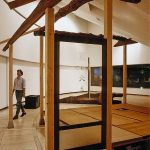T H E U R B A N E N V I R O N M E N T I N J A P A N : M Y H O M E S W E E T H O M E I N R U I N S, Setagaya Art Museum, Tokyo, Japan, 1992
Curator: Junichi Shioda
scrap wood, tatami mat, earth, two monitors
The installation consisted of two symbolic reconstructions of sections of the house where three generations of Nagasawa’s family had lived. One was a skeleton structure containing a few posts, roof beams, a traditional sliding door, and tatami mat floors (traditionally made of rice straw) all taken from the original house that had been torn down a few months before the exhibition opened.
A video monitor embedded in the tatami mat floor showed home movies of family gatherings as filmed by Nagasawa’s grandfather, using his old 8mm camera. Included was a footage of Nagasawa, taking her first steps in the house. The viewer could walk around and inside the structure to get a physical sense of the space surrounding them. The second reconstruction was a single post standing on a patch of earth. The earth had been transported from the demolished house site and formed in the shape of the actual floor plan of the house, to scale but reduced in size. This post had been the core of the house and held the marks of the physical height of Nagasawa and her siblings each year as they were growing up. In the center of the room, a large video monitor showed the entire process of the demolition, as filmed by Nagasawa.
While the installation explored the personal relationship of Nagasawa and her home, it also addressed the complex Japanese concept of “home,” referring to family, community, society, and nation. By exposing her home as a metaphor, Nagasawa confronted the deterioration and breakdown of various issues in politics, economics, society, and her culture of origin.


